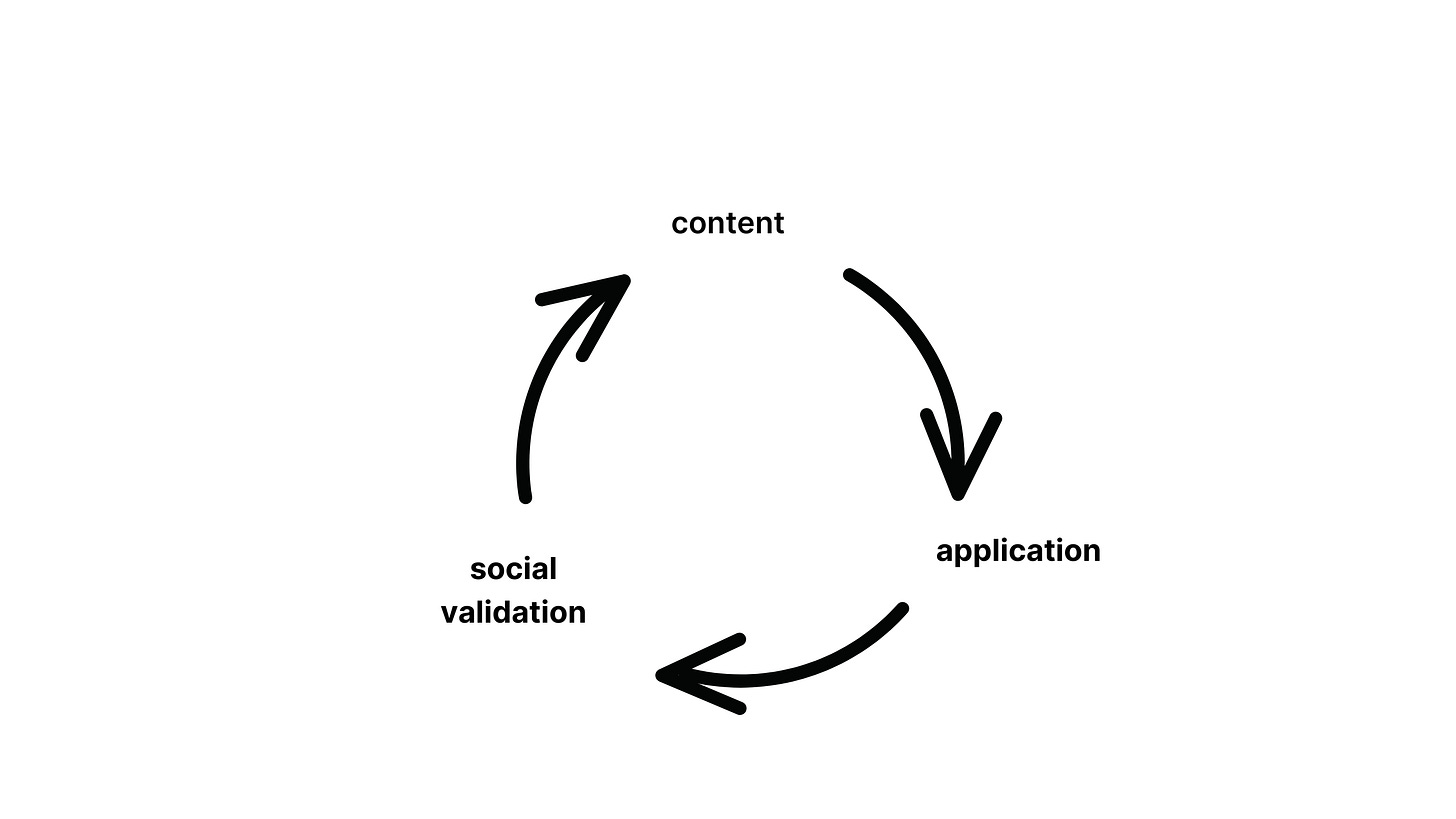What Makes a Great Learning Experience?
Over the past four years of teaching and running online courses, I’ve discovered that a great learning experience follows a clear and effective path. At the heart of this path lies what we at NextWork call The Learning Loop.
The Learning Loop comprises three critical components: content, application, and social validation. Each of these parts plays a vital role in creating a learning journey that is engaging, practical, and rewarding. When implemented effectively, the cycle repeats itself, continuously enhancing the learner’s growth.
Part 1: Content
The first step of the Learning Loop is content. Great content is the foundation of any successful learning experience. How the content is delivered matters just as much as what is taught. To captivate learners and meet their needs, content must be tailored to their current skill level and presented in an engaging, accessible way.
What Makes Great Content?
Accuracy: The content needs to be correct and trusted by learners.
Skill Level: The content should meet learners where they are, whether they’re beginners, have some experience, are highly skilled, or are industry leaders.
Tone: The tone of delivery should resonate with the audience. This could range from chatty and casual to blunt and professional, depending on what feels most authentic and relatable.
Length: Effective learning content aligns with the audience’s attention span—10 minutes for quick lessons, 30 minutes for deeper dives, or longer sessions for intensive learning.
Type and Format: Videos, audio, text, flashcards, or a combination of these should be used based on the topic and audience preferences. The format could involve concise, actionable insights or long-form, in-depth explorations.
Risks to Avoid:
Information Overload: Bombarding learners with too much information can hinder retention.
Lack of Context: Without clear context, learners may struggle to connect new knowledge to their existing understanding.
Lack of Engagement: If the content isn’t captivating, learners will disengage.
Part 2: Application
Content provides the foundation, but without application, knowledge remains abstract. Applying what you’ve learned is crucial to mastering new concepts and skills. Theory only takes you so far; it’s practice that brings real understanding.
What Makes Great Application?
Accurate Steps: Clear and precise instructions help learners implement what they’ve learned without frustration.
Relevance: Activities should directly tie into real-world situations learners will face.
Understandable: Tasks need to be broken down into manageable pieces that are easy to follow.
Momentum: A good application process maintains learners’ interest and progress.
Responsive Support: Immediate help ensures learners can overcome obstacles as they arise.
Risks to Avoid:
Lack of Immediate Support: When learners get stuck, frustration can derail their progress.
Unclear Outcomes: Without a clear goal, learners may struggle to see the value of their efforts.
Difficulty Level: Tasks that are too hard or too easy can demotivate learners.
By providing learners with actionable steps and relevant challenges, the application phase transforms theoretical understanding into practical competence.
Part 3: Social Validation
The final part of the Learning Loop is social validation. This step reinforces learning by allowing individuals to showcase their achievements, gain recognition, and build confidence. Social validation not only celebrates progress but also motivates learners to continue the cycle.
What Makes Great Social Validation?
Personal Brand Building: Learners can showcase their achievements, strengthening their professional identity.
Industry Recognition: Validation from respected figures or organizations boosts credibility and motivation.
Standing Out: Opportunities to share unique skills and insights help learners distinguish themselves.
Ease of Implementation: Platforms or systems should make it simple for learners to share their accomplishments.
Risks to Avoid:
Fear of Judgement: Some learners may hesitate to share their work due to self-doubt.
Low Community Engagement: Without an active community, social validation loses its impact.
Comparison Paralysis: Comparing oneself to others can lead to discouragement rather than motivation.
Lack of Industry Respect: If learners feel their work isn’t taken seriously, the validation becomes hollow.
When done right, social validation creates a sense of pride and accomplishment, fuelling the desire to embark on the Learning Loop again.
Currently, completely a Learning Loops is a painful and long experience for a student.
The content can come from multiple confusing sources, majority of which are overwhelming and unclear. Applying the things you’ve learnt requires expensive bootcamps, internships, or a job. Then social validation needs to be a degree or certification, which often aren’t trusted by employers….or you feel like you need to spend hours posting on LinkedIn and become an influencer. Not easy!
Fortunately, this can be done well. We know what a great learning experience needs, and are here to build it for the world.
The Endless Cycle of Growth
The beauty of the Learning Loop when it is done correctly lies in its cyclical nature. Starting with engaging content, moving through practical application, and culminating in meaningful social validation, the loop is a very addictive experience.
Learning is more than just access to content; it’s the full Learning Loop experience.





